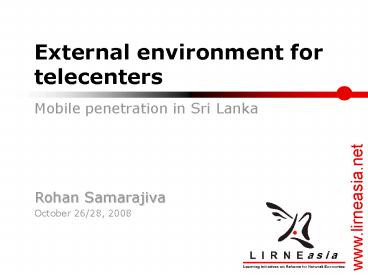External environment for telecenters - PowerPoint PPT Presentation
Title:
External environment for telecenters
Description:
Many websites, almost all newspapers easily accessible (some allowing comments) ... Again, different from the Philippines: mostly housewives (32%), those employed ... – PowerPoint PPT presentation
Number of Views:22
Avg rating:3.0/5.0
Title: External environment for telecenters
1
External environment for telecenters
- Mobile penetration in Sri Lanka
Rohan Samarajiva October 26/28, 2008
2
Fixed and mobile growth, 1992-98
3
New media?
- Slightly over 500,000 fixed phones (mostly
wireline) and close to 200,000 mobile phones - No ADSL, no WiMAX, no HSPA, little use of SMS,
but some info services using cell broadcasting
channels and few people using dial-up (even ISDN
came in 1999) no WiFi - Few websites exist, but very static (LBO starts
in 1998) no blogs no blog aggregators - 700,000 calling opportunities
4
Fixed mobile growth 2001-2007
I million to 8 million mobile 1 million to 3
million fixed
5
New media?
- Close to 3 million fixed phones (majority
wireless), 8 million mobile phones (all GSM),
around 100,000 fixed broadband users and several
thousand mobile broadband users - ADSL since 2003, WiMAX since 2007, HSPA since
2007, WiFi since 2003 - Heavy use of SMS, info services using cell
broadcasting channels, mobile voting, mobile
payments, cameras on many handsets, MMS available
and used - Many websites, almost all newspapers easily
accessible (some allowing comments) 1,000 blogs
(in all three languages) 3 blog aggregators
lots of social networking some twittering - E-commerce, basic e government services emerging
- 11,000,000 calling opportunities
6
Bottom of the Pyramid almost everyone has
access, but not ownership
7
Overall access is very high
- Used phone in the last 3 months
South Asia South Asia South Asia South East Asia South East Asia
Pakistan India Sri Lanka Philippines Thailand
Used phone in last 3 months 98 94 92 93 95
8
But ownership is low 41 of Sri Lanka BOP in
2006 (higher now, projected 72)
Pakistan India Sri Lanka Philippines Thailand
Total number of phones per 100 population 29.38 13.96 29.10 45.30 57.80
Source National regulatory agencies (mid 2006) 2005, 2004 F 4.6 M 8.2 U 32 R 2 Source National regulatory agencies (mid 2006) 2005, 2004 F 4.6 M 8.2 U 32 R 2 Source National regulatory agencies (mid 2006) 2005, 2004 F 4.6 M 8.2 U 32 R 2 Source National regulatory agencies (mid 2006) 2005, 2004 F 4.6 M 8.2 U 32 R 2 Source National regulatory agencies (mid 2006) 2005, 2004 F 4.6 M 8.2 U 32 R 2 Source National regulatory agencies (mid 2006) 2005, 2004 F 4.6 M 8.2 U 32 R 2
9
So, mainly use public phones
In Sri Lanka at BOP 30 use public phones
10
Bottom of the Pyramidsome do own phones
41 in Sri Lanka
11
Why own a (mobile) phone?
Convenience is key privacy is more of a concern
for higher income countries
12
???
13
Mobiles used more often by males at BOP in South
Asia
of mobile owners at BOP
14
Female mobile owners at BOPwho pays for their
mobile?
of female mobile owners at BOP
15
Bottom of the Pyramid most dont own phones
64
16
Sri Lanka second highest gender difference
Non-owners at BOP
of non-owners at BOP
17
Gender difference of non-owners
of non-owners at BOP
In Sri Lanka more women use others (neighbors,
friends) phones, also use public phones
18
Why not own a phone?
Affordability is the key barrier to phone
ownership
19
Usage patterns owners non-owners
100
20
Low users are non-owners in South Asia
of Diary respondents
Source Diary
21
Internet? What Internet?
Pakistan India Sri Lanka Philippines Thailand
Use the Internet 1.91 0.29 1.51 8.77 10.41
Pakistan India Sri Lanka Philippines Thailand
Not heard of Internet 36 72 29 14 36
22
Bottom of the pyramid
- International calls who is calling?
Table of contents
23
Mostly local at BOP, but some international in LK
PH
Source Diary
24
1.5 million expatriate workers, 90 in West Asia
- 44 male 56 female, according to SLBFE
- 840,000 women separated from families
- 660,000 men separated from families
- Dont they need to talk?
25
International calls Who is calling/being called?
- Primarily rural females, with primary or
secondary education, aged 25-54 - Different from the Philippines more males,
mostly living in urban areas, with higher levels
of education, mostly below 34. - The bulk of the calls are made by trained
untrained laborers (25 ) Farmers / agricultural
workers (16) Housewives (13) - Again, different from the Philippines mostly
housewives (32), those employed in services
(18) or unemployed (17) - 2006 data excluding NE provinces
26
Gender of the caller/callee (as a percentage of
international calls made)
27
Location of the caller/callee (as a percentage of
international calls made)
28
Educational attainment of callers/callees
29
Age of the caller (as a percentage of
international calls made)
30
if we stop thinking of the poor as a burden and
start recognizing them as value conscious
consumers, a whole new world of opportunity will
open up C.K. Prahalad. The Fortune at the
BOP.































